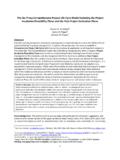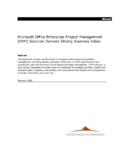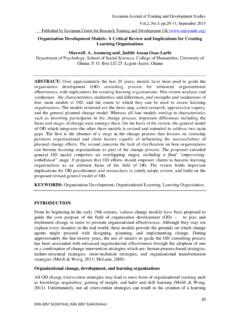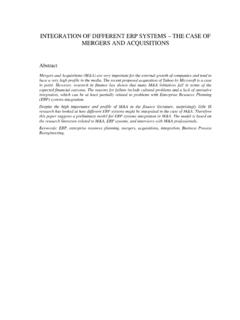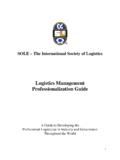Transcription of A Framework for Managing the Innovation Process …
1 A Framework for Managing the Innovation Process Niek D du Preez1 , Louis Louw2 1 Stellenbosch University, Department of Industrial Engineering, South Africa 2 Indutech (Pty) Ltd, Brandwacht Office Park, South Africa Abstract--Successful Innovation requires an integrated design Process , integration in the design of the enterprise, the design of the product, as well as the design and implementation of new technologies. Such an integrated design effort requires good collaboration and management of the designs, and should be supported by efficient knowledge management techniques and tools. If Innovation is to help a business grow and improve its competitiveness, it is also important to plan the Innovation carefully.
2 Though some ideas may just fall from the sky or come out of the blue , an organisation should also have a strategic vision of how the business and the enterprise should develop. The Enterprise should not wait for the Innovation to arrive arbitrarily, but rather proactively plan for Innovation incorporating market trends, the competitive landscape, new technology availability, and changes in customer preferences and trends in order to create fruitful terroir conducive for innovative thinking. Such an enterprise will also pro-actively manage the knowledge supply chain that supports Innovation .
3 This paper presents a combined convergent and divergent approach for Managing Innovation within an Innovation landscape that contextualise domains, role-players, decision points and knowledge network components . The Innovation management model specifically focuses on the use of roadmapping for planning and deploying Innovation within a collaborative deployment environment. A case study illustrating the use of parts of the Framework within the insurance industry is also presented. I. INTRODUCTION Innovation is widely recognised by industry and academics as an essential competitive enabler for any enterprise that wants to remain competitive and survive and grow [5],[7].
4 Surveys such as the annual Innovation survey from The Boston Consulting Group [1] however, suggest that although the importance of Innovation is fully realised by most enterprises and they continue to spend more and more on Innovation , many of these initiatives do not generate satisfactory profit or competitive advantage. The problem does not lie in the invention part or the generation of innovative ideas, but more in the successful management of the Innovation Process from an idea to a successful product in the market [12], [13], [18]. Booz Allen Hamilton [11] found that a common denominator among successful innovators is a rigorous Process for Managing Innovation , including a disciplined, stage-by-stage approval Process combined with regular measurement of every critical factor, ranging from time and money spent to the success of new products in the market.
5 " This seems to be in stark contrast to the traditional wisdom that inventions cannot be planned, but require innovative and free thinking. Yet even Edison realised that a lot of perspiration is required in balance with the inspiration. Any Innovation management Framework should thus include a good combination of structure and flexibility in order to successfully deploy all the elements of successful Innovation . Fig 1 depicts the Process as viewed by the authors. Fig. 1 - Components of the Innovation life cycle This paper presents an Innovation Process model developed by combining concepts from various available new product development and Innovation Process models published in literature and practical experience obtained from various industrial applications.
6 This model is presented as a roadmap to guide users through the Innovation Process . The paper introduces different Innovation processes as well as new product development models from the literature. Through synthesis important generic characteristics and components of current Innovation Process models are identified. A new Innovation Process model (the Fugle model ) developed from combined learning from the literature as well as practical experience is then presented. Finally a case study is presented that describes an application and refinement of the model within an insurance company.
7 II. Innovation Process MODELS An extensive corpus of literature exists on Innovation processes describing the management and the phases of the Process from idea to commercialized product [17], [16], [14]. The Innovation Process models have evolved in six generations from simple linear models to increasingly complex interactive models (refer to Table 1). TABLE 1 - DEVELOPMENT OF Innovation MODELS (ADOPTED FROM [14]) model Generation Characteristic Technology push First Simple linear sequential Process , emphasis on R&D and science Market pull Second Simple linear sequential Process , emphasis on marketing, the market is the source of new ideas for R&D Coupling model Third Recognizing interaction between different elements and feedback loops between them, emphasis on integrating R&D and marketing Interactive model Fourth Combinations of push and pull models, integration within firm, emphasis on external linkages Network model Fifth Emphasis on knowledge accumulation and external linkages.
8 Systems integration and extensive networking Open Innovation Sixth Internal and external ideas as well as internal and external paths to market can be combined to advance the development of new technologies The first and second generation models are linear models explaining Innovation as either being pulled by market needs, or pushed by technology and science. Fig. 2 illustrates these first and second generation linear models. The third generation model is a coupling model that recognises the influence of technological capabilities and market needs within the Framework of the innovating firm (refer to Fig.)
9 3). Fig. 2 First and Second Generation models of the Innovation Process : Technology Push and Pull [19] Fig. 3 Third Generation Coupling model of Innovation [15] Although the coupling approach contains feedback loops it is essentially a sequential model with limited functional integration. One of the most well known sequential or linear Innovation Process models is the Stage-Gate model from Cooper [3]. This model divides the product Innovation Process into stages with defined gates acting as decision points between the stages (Refer to Fig. 4). At the end of each stage is a stage gate, which consists of a phase review to evaluate whether the previous phase or stage was successfully completed.
10 If the project is reviewed positively, work proceeds to the next phase. If not, then work continues or iterates within that phase until it can successfully pass the gate. Fig. 4 Stage Gate Process [3] The advantage of the stage gate Process is that it ensures better quality in the Innovation Process . The gates also help to ensure comprehensiveness, no critical activities have been omitted. A disadvantage of this model could be that the gates are too rigorous, especially in the early stages of idea and concept generation. Another critique is also that it is a linear or sequential Process . Although such a sequential approach with evaluation gates enhances the effectiveness and efficiency of incremental Innovation processes, for more radical innovations characterised by high uncertainty a flexible, learning-based approach is appropriate.
